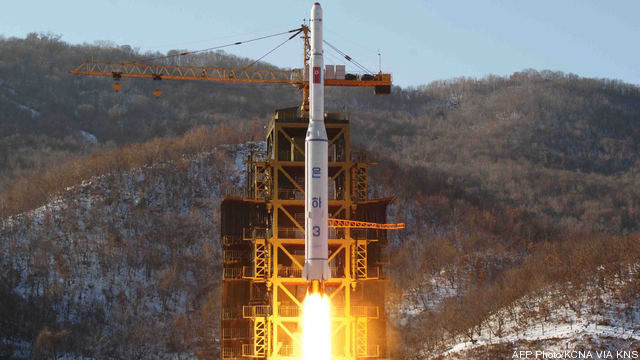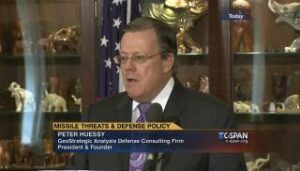Peter Huessy, president of defense consulting firm GeoStrategic Analysis, is an expert on international nuclear issues and organizes the Congressional Breakfast Seminar series for the Air Force Association.
What the Trump Administration Is Really Doing About North Korea
Posted on

Since the end of the Cold War and then the Agreed Framework in 1994, the United States has engaged in a serial “Big Wink” with respect to denuclearization of the Korean peninsula.
First, we officially dismissed the idea that the Chinese fund the North Korean nuclear and missile programs through five key banks in China.
Second, we dismissed the idea that the North’s military capability was part of a Chinese plan to kick the United States out of the western Pacific as part of their 100-year marathon plan for hegemonic control. Part of this false narrative we came to believe was China’s “peaceful rise”.
 Third, we dismissed the idea of putting together serious sanctions because to do so would “disrupt” trade with China.
Third, we dismissed the idea of putting together serious sanctions because to do so would “disrupt” trade with China.
Fourth, we dismissed the idea that the DPRK arsenal of warheads and missiles was a tool with which to drive a wedge between the USA and its South Korean and Japanese allies.
Fifth, we too often assumed the regime in the North would collapse or otherwise disappear, or that some reunification was really possible, all in order to continue the charade that no serious United States action was necessary to deal with the DPRK threat.
Sixth, we assumed that unlike every other agreement the DPRK agreed to on nuclear and military matters, the North Koreans would adhere to the terms of a nuclear deal THIS time.
Finally, we bought into the fairy tale that the North had nuclear weapons because they had to defend themselves against the bullying United States, a nuclear defense that Libya’s Ghaddafi and Iraq’s Saddam did not have. And we all saw what happened to them!
The Trump administration understood all of this.
That is why they decided to engage in a multi-step program.
First, we engaged with China to see how serious they were about putting the North Korean Frankenstein—which they created– back in the laboratory. Done.
Then, we follow that up with more serious sanctions, although we understood anything approved by the United Nations had to pass muster with Russia and China. Therefore, whatever was agreed to might be better than what the Trump administration inherited, but still not be sufficient. Done.
We then examine alternatives for sanctions we implement which could be combined with the use of such tools as the Proliferation Security Initiative to interdict technology, oil and other resources from reaching North Korea. Cutting off Chinese banks would be a good start. In process.
We would then follow that up with simultaneously deployments of better and greater numbers of missile defenses in ROK and Japan, as well as the United States, fully aware that China would strenuously object and further seek to drive a wedge between the United States and its Pacific allies. Both done and in progress.
Next, we improve our defense posture in the Pacific. Of critical importance is we would eliminate the foolish 2010 defense budget caps that, as former Sen. James Talent has explained, have cut over $1 trillion from the United States defense budgets. How can anyone take us seriously if we have not increased our defense budget sufficiently while seeking a better defense capability? In process.
We would engage in enhanced diplomacy, first by cementing our relationships with South Korea and Japan, and emphasizing our joint partnerships. Defense Secretary Jim Mattis and Secretary of State Rex Tillerson did this. As did President Trump. Done.
We would also agree to talk with the North Koreans, but not as part of some endless diplomatic rope-a-dope leading nowhere. If the North came to the table with a plan for denuclearization, we would be all ears. Done.
Yes, the North has said they would give up their nuclear bombs, but only if we dropped our “hostile policy” and gave up our ability to strike the North with nuclear weapons. How the United States could prove our nuclear deterrent is not targeted at North Korea but is targeted elsewhere was not explained.
Lost in the cacophony of criticism of the Trump Administration is that the North Korean regime has repeatedly attacked the United States, the Republic of Korea and Japan with impunity, causing hundreds of casualties, from grabbing the USS Pueblo to shelling a South Korean village to blowing up a Japanese airliner over the Gulf of Siam. Not once did the United States respond with military action. The Trump administration knows this and has clearly stated that will change. Done.
This is not a contest between a rogue regime and the leader of the free world. It is a struggle between a coalition of totalitarian regimes seeking regional and world hegemony –including China and North Korea — and the civilized world, protected by the western NATO and East Asian alliances, of which the United States is the leader.
This the Trump Administration and our president understand. The president’s remarkable speech in Poland contained these relevant words: “The triumph of the Polish spirit over centuries of hardship gives us all hope for a future in which good conquers evil, and peace achieves victory over war… The fundamental question of our time is whether the West has the will to survive. Do we have the confidence in our values to defend them at any cost? Do we have the desire and the courage to preserve our civilization in the face of those who would subvert and destroy it?”
Subscribe to our newsletter
Promotions, new products and sales. Directly to your inbox.
